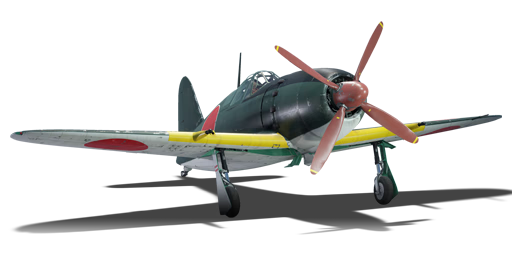

Aviation
J2M5 (Type 5)
IV
Rank
AB
5.7
RB
5.0
SB
4.7
Battle rating
Japan
Research country
Fighter
Main role
3,850

Purchase

Premium vehicle
Status
General information
The J2M5 Model 33 (30 mm), designated as Raiden Mod.33 (Prototype) (雷電三三型 (原型)), is a prototype of the J2M5 replacing the four 20 mm cannons with two 30 mm Type 5 cannons. Due to lack of material and manpower, as well as constant bombing, it never entered production lines.
It was introduced in Update 1.51 "Cold Steel". While offering the same flight characteristics as the Raiden it was based on, its armament is of a different calibre, both physically and in usage. The Type 5 30 mm's this J2M5 carries offer a lot of punch for a very limited ammo capacity, so it's up to the pilot to make every trigger pull count.
Camouflages
Flight performance
Max speed
at 6,580 m
615570645588 km/h
Rate of Climb
17.512.923.912.9 m/s
Turn time
1920.618.120 s
Max altitude
11,500 m
Takeoff Run
300 m
Landing
flaps
flaps
Take-off
flaps
flaps
Combat
flaps
flaps
Air
brake
brake
General characteristics
Crew
1 person
Engine
Length
9.9 m
Wingspan
10.8 m
Wing Loading
170 kg/m²
Weight:
Base weight
2.983.072.913.05 t
Fuel in main tanks
0.43 t (1h 2m)
Limits:
Max Speed Limit (IAS)
820 km/h
Mach Number Limit
0.81 M
G limit
≈ -8/11 G
Flap Speed Limit (IAS)
L / T / C
280 / 455 / 489 km/h
Gear Speed Limit (IAS)
350 km/h
Offensive armament
2 × 30 mm Type 5 cannon
Ammunition
84 rounds
Fire rate
500 shots/min
One-second Burst Mass
2.97 kg
| Belt | Belt filling | Armor penetration (mm) at a distance: | |||||
|---|---|---|---|---|---|---|---|
| 10 m | 100 m | 500 m | 1000 m | 1500 m | 2000 m | ||
| HEF/HEF-I/HEF-T/APHE | 38 | 36 | 28 | 21 | 16 | 12 | |
| HEF-T/HEF-I/APHE/HEF/HEF | 38 | 36 | 28 | 21 | 16 | 12 | |
| HEF-T/APHE/APHE/APHE | 38 | 36 | 28 | 21 | 16 | 12 | |
| HEF-T | 5 | 5 | 4 | 3 | 3 | 3 | |
| HEF | 5 | 5 | 4 | 3 | 3 | 3 | |
Suspended armament
Setup 1
2 × 60 kg Navy Type 97 Number 6 ground bomb
Economy
Repair cost
AB
1,688 

RB
4,331 

SB
5,039 

Crew training
10,000 

Experts
290,000 

Aces
940 

Research Aces
960,000 

Reward multiplier
AB / RB / SB
 2 x (95 / 225 / 450) %
2 x (95 / 225 / 450) % 
 2 x 166 %
2 x 166 % 

Premium vehicle
All modifications are unlocked
Flight performance | |
|---|---|
Survivability |
|---|
Weaponry |
|---|
Rating by players
You must play more than 3 battles for the last week and more than 10 battles in a vehicle to rate it.
Like:
21
Flight performance:
Not enough ratings
Survivability:
Not enough ratings
Aerial combat:
Not enough ratings
Ground attack:
Not enough ratings
Balance:
Not enough ratings
Tips & Tricks
This space is currently empty
Do you know any interesting vehicle features?
Loading...
No articles about this vehicle yet
Become the first author and get rewards!
Write a guide, tell about interesting historical facts, make a tutorial or simply an interesting post.
No more content